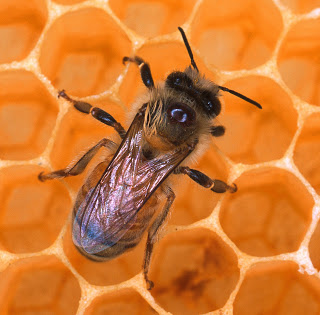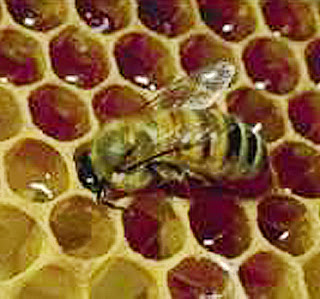Biology

· Bees fly an average of 13-15 mph. · A colony of bees has to fly almost fifty-five thousand miles and tap two million flowers to make one pound of honey.
· A colony of bees has to fly almost fifty-five thousand miles and tap two million flowers to make one pound of honey.
- Mutualism, Parasitism, Commensalism
What are Mutualism, Parasitism and Commensalism? Mutualism is a relationship between organisms of different species in which both benefit from the relationship. For example, bees and flowers. The bees help pollinate the flowers for reproduction...
- Which Of The Following Are Analogous Organs?
A) Thorns and tendrils of Bougainvillea and CucurbitaB) Mouth parts of honey bee and mosquito C) Forelimbs of whales, bats, cheetah and humans D) Eyes of Octopus and mammals The correct answer is: D) Eyes of Octopus and mammals...
- Pollen: Evolution
In this picture is pollen that got stuck to the ground because of juice or water. Pollen has been flying around because plants and flowers are blooming and they are ready to fertilize. Pollen is like a tiny grain inside id a seed plant which usually...
- Differences And Similarities Between Bees And Wasps
Comparison between Bees and WaspsSimilarities Characteristics Bees Wasps Kingdom Animalia Animalia Phylum Arthropoda Arthropoda Class Insecta Insecta Order Hymenoptera Hymenoptera Suborder Apocrita Apocrita Morphology Long...
- Heart, Blood & Blood Vessels- Facts
The human body has approximately 37,000 miles of capillaries.The aorta, which is largest artery located in the body, is about the diameter of a garden hose.Women hearts beat faster than men.Three years after a person quits smoking, there chance of having...
Biology
Honeybee facts

· Bees fly an average of 13-15 mph.
· A bee travels an average of 1600 round trips in order to produce one ounce of honey; up to 6 miles per trip. To produce 2 pounds of honey, bees travel a distance equal to 4 times around the earth.
· Honeybees visit about 2 million flowers to make one pound of honey.
· During honey production periods, a bee's life span is about 6 weeks.
· Just a single hive contains approximately 40-45,000 bees!
· Honeybees are the only insects that produce food for humans.
· About 8 pounds of honey is eaten by bees to produce 1 pound of beeswax.
· Beeswax production in most hives is about 1 1/2% to 2% of the total honey yield.
· The average hive temperature is 93.5 degrees.
· Queens will lay almost 2000 eggs a day at a rate of 5 or 6 a minute. Between 175,000-200,000 eggs are laid per year.
· The speed at which honey bees fly is at 15 miles per hour.
· The sole purpose of a drone bee is to mate with the queen bee.
· Bees from the same hive visit about 225,000 flowers per day. One single bee usually visits between 50-1000 flowers a day, but can visit up to several thousand.
· Honeybees have hair on their eyes.

· A honey bee strokes its wings about 11,500 times a minute.
· Bees can communicate with other bees by dancing. Their dance can alert other bees as to which direction and the distance nectar and pollen is located.
· It takes 12 honeybees to make one teaspoon of honey. In a lifetime, on average a honey bee produces 1/12th of a teaspoon of honey.
· In one trip, a honey bee visits about 75 flowers.
· In one day, a queen bee can lay up to 1500 eggs in one day.
· Honeybees use the sun as a compass which helps them navigate.
· A honey bee has four wings.
· A bird called the bee eater in areas of Africa thinks that riding around on the backs of other animals is fun!
· The honeybee has to travel an average of 43,000 miles to collect enough nectar to make a pound of honey!
- Mutualism, Parasitism, Commensalism
What are Mutualism, Parasitism and Commensalism? Mutualism is a relationship between organisms of different species in which both benefit from the relationship. For example, bees and flowers. The bees help pollinate the flowers for reproduction...
- Which Of The Following Are Analogous Organs?
A) Thorns and tendrils of Bougainvillea and CucurbitaB) Mouth parts of honey bee and mosquito C) Forelimbs of whales, bats, cheetah and humans D) Eyes of Octopus and mammals The correct answer is: D) Eyes of Octopus and mammals...
- Pollen: Evolution
In this picture is pollen that got stuck to the ground because of juice or water. Pollen has been flying around because plants and flowers are blooming and they are ready to fertilize. Pollen is like a tiny grain inside id a seed plant which usually...
- Differences And Similarities Between Bees And Wasps
Comparison between Bees and WaspsSimilarities Characteristics Bees Wasps Kingdom Animalia Animalia Phylum Arthropoda Arthropoda Class Insecta Insecta Order Hymenoptera Hymenoptera Suborder Apocrita Apocrita Morphology Long...
- Heart, Blood & Blood Vessels- Facts
The human body has approximately 37,000 miles of capillaries.The aorta, which is largest artery located in the body, is about the diameter of a garden hose.Women hearts beat faster than men.Three years after a person quits smoking, there chance of having...
